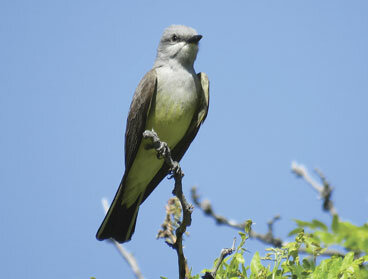
Photo courtesy Byron Greco
This week’s Bird of the Week, compliments of the Weminuche Audubon Society and Audubon Rockies, is the western kingbird.
Both the scientific name, tyrannus verticalis, and the common one, kingbird, fit this bird’s attitude and posture. This member of the tyrant flycatcher family is known to aggressively defend its territory and nest from competitors and predators.
The robin-sized western kingbird will mount a full-on chasing attack, pecking at the backs and tails of much larger hawks, crows or owls that stray too close to the nest. Wing fluttering, loud buzzy calls and bill snapping are all warning signs used to ward off rival kingbirds and predators.
Western kingbirds will build their nests in the crotch of a tree or shrub, in an abandoned woodpecker cavity and on man-made structures including windmills, buildings and at the cross-arms on utility poles. Despite the kingbird’s vigilance and ferocious defense, predation by birds, snakes and squirrels is a major cause of nest failure.
The gray-headed western kingbird has a lemon-yellow-colored belly, whitish throat and chest, and has a black tail with white outer feathers. The male’s red crown of feathers is only visible when he’s really excited. The western is similar in appearance to the Cassin’s kingbird, which also breeds in our area but has a more distinctly white chin and darker gray head.
Western kingbirds occupy open and woodland edge habitats below 7,000 feet in elevation across the western half of the continental U.S. during summer. In the right breeding habitat, these noisy birds are easy to spot on conspicuous perches: fence posts, utility lines and snags.
These large flycatchers watch from the perch for insects in the air and on the ground before flying out to snatch one. Larger prey may be shaken or beaten against the perch before being consumed.
Early in September, these birds start leaving their breeding grounds here for winter spots in southern Mexico and Central America.
For information on events, visit www.weminucheaudubon.org and www.facebook.com/weminucheaudubon/.